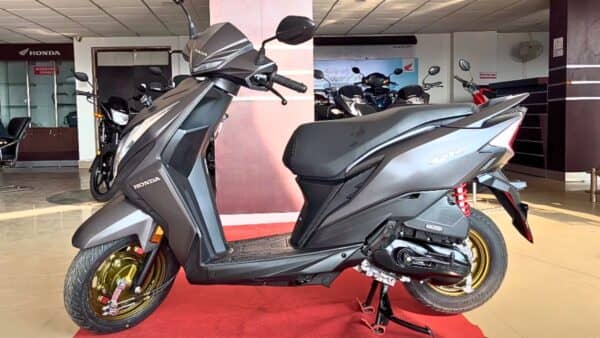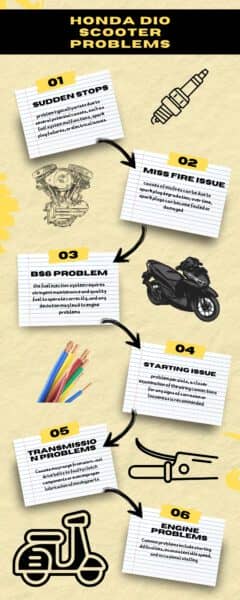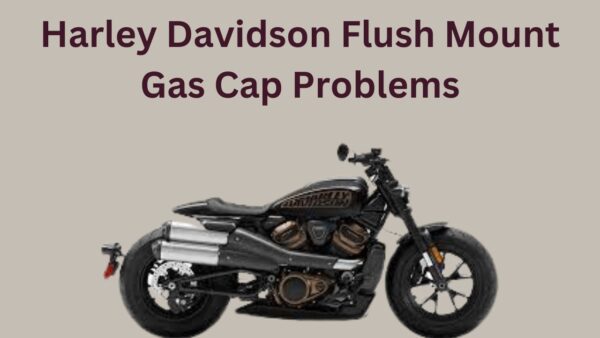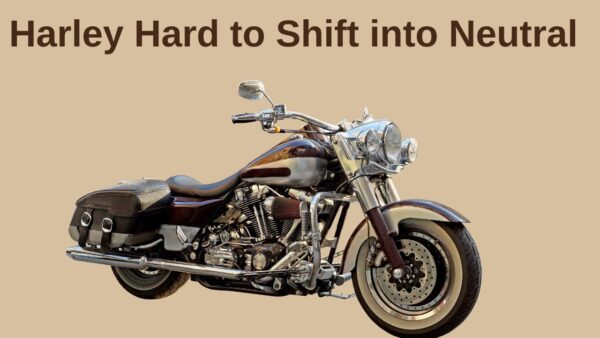The Honda Dio, a prominent scooter known for its sleek design and reliability, has been a popular choice among riders worldwide.

However, like any vehicle, it comes with its own set of potential issues that owners encounter over time.
In this article, we will dive into some of the most common problems reported by riders, from engine troubles to electrical glitches.
Honda Dio Problems
One of the most common issues is a less comfortable ride on rough terrain owing to its stiff suspension and a tendency for decreased performance over time with its CVT gearbox.

There have also been complaints regarding the Dio’s braking system, engine, transmission, and BS6 problems.
1. Sudden Stops
The Honda Dio is known for its sleek design and efficiency; however, some riders have reported issues with sudden stops, which can be alarming and dangerous.
This problem typically arises due to several potential causes, such as fuel system malfunctions, spark plug failures, or electrical issues.
A clogged fuel filter or carburetor can hinder gas flow, causing the engine to stall.
However, a worn or corroded spark plug might fail to provide the necessary spark to keep the engine running.
Moreover, electrical problems like a faulty ignition switch or issues with the Electronic Control Unit (ECU) can also lead to unexpected shutdowns.
To address these sudden stop issues, you should:
- Check and replace the fuel filter and clean the carburetor regularly to ensure a clear fuel passage.
- Inspect and change the spark plug if it is found to be faulty or if it’s been in use for a prolonged period.
- Examine the electrical system, including the battery, ignition switch, and ECU connections, for any loose or corroded components.
If the problem persists, it is recommended to consult a professional mechanic who can perform a comprehensive diagnostic check to isolate and fix the issue.
2. Miss Fire Issue
One common issue that users encounter is the occurrence of misfires.
A misfire occurs in an engine when an expected combustion event fails to occur, disrupting the engine’s normal operation and leading to various performance issues.
For the Honda Dio, this can result in a sudden loss of power, irregular idling, or the engine failing to start.
The causes of misfires can be due to spark plug degradation; over time, spark plugs can become fouled or damaged.
Which leads to inconsistent sparks that are essential for igniting the air-fuel mixture in the engine.
Related: Honda CB300R Common Issues
However, problems with the fuel system, such as a clogged fuel filter or issues with the fuel injectors, can prevent the correct amount of fuel from entering the combustion chamber.
On the other hand, faulty ignition coils or damaged wiring can also contribute to misfires by hindering the electrical signals needed to create a spark.
Addressing these misfire issues typically begins with diagnostic checks to pinpoint the exact cause.
Once you have identified the problem, the replacement of faulty parts, such as the spark plug or ignition coil, can resolve it.
3. BS6 Problem
The Honda Dio, a popular scooter in numerous regions, has not been immune to complaints concerning its Bharat Stage 6 (BS6) compliant engines.
Some users have reported issues like stalling, lower mileage, and uneven acceleration, which are attributed to the intricate BS6 emission norms compliance.
The BS6 emission standards, implemented to reduce vehicular pollution, necessitated significant changes in engine design, including the incorporation of advanced fuel injection systems for cleaner combustion.
However, the owners of the Dio have expressed concerns that these modifications, while environmentally beneficial, compromise the scooter’s performance and reliability.
For instance, the fuel injection system requires stringent maintenance and quality fuel to operate correctly, and any deviation may lead to engine problems.
Proper handling of these issues, such as the fuel system, using high-quality fuel, and timely diagnostics to prevent and address any issues that arise, can help fix the issue.
4. Starting Issue
One of the commonly reported problems is related to the starting issues that stem from a malfunctioning electric starter.
This problem can be traced back to several underlying factors, such as a depleted battery, faulty wiring, or a defective starter motor.
To diagnose and resolve this issue, you should check the battery’s charge level, ensuring it holds the necessary voltage to crank the engine.
If the battery is fully charged and the problem persists, a closer examination of the wiring connections for any signs of corrosion or looseness is recommended.
In cases where the battery and wiring are not at fault, the starter motor itself may be the culprit and could require a replacement.
It’s essential to consult the motorcycle’s manual and seek professional assistance if needed to ensure proper troubleshooting and repair.
5. Transmission Problems
Over time, most riders have been reported to encounter transmission problems with their scooter.
These issues can result in a sudden loss of power, difficulty in accelerating, or abnormal noises coming from the transmission area.
Causes may range from worn-out drive belts to faulty clutch components or even improper lubrication of moving parts.
To fix the issue, it’s crucial to first identify the symptoms. A loss of power, for example, could signify a stretched or worn belt, which requires replacement.
Noise during operation might indicate a lack of transmission fluid or deteriorating gears.
Regular maintenance, including belt inspections and fluid level checks, can preempt many of these problems.
In cases where the transmission problem is more complex, consult with a certified mechanic and consider the replacement of internal components.
6. Engine Problems
While a reliable and efficient scooter, it has had instances where users reported issues related to its engine.
Common problems include starting difficulties, inconsistent idle speed, and occasional stalling.
Upon deeper investigation, these issues are often traced back to causes such as spark plug deterioration, carburetor malfunctions, or the accumulation of debris in the fuel line.
To comprehensively address these concerns, you should regularly check spark plugs for corrosion or damage and replace them as needed.
The carburetor, a critical component for mixing air and fuel, requires periodic cleaning to ensure there are no clogs affecting the scooter’s performance.
Furthermore, ensuring that the fuel line is free from blockages will help maintain a steady flow of fuel to the engine.
In case these measures do not resolve the problem, it may be indicative of a more serious issue, such as engine compression problems or wear and tear of internal components, which are best examined by a certified mechanic.
7. Electrical Problems
One common issue that riders face is an electrical problem concerning the scooter’s electrical mechanism.
This issue often results in difficulty in starting the vehicle, with the engine failing to turn over when the ignition switch is activated.
The underlying causes can be diverse, from a depleted or faulty battery, loose or corroded electrical connections or a defective starter motor.
Diagnosing and resolving this electrical problem begins with simple checks, such as ensuring the battery is charged, and terminals are clean and secure.
If the battery and connections are in good order, further investigation into the starter motor and related circuitry will be necessary.
In some cases, the use of a multimeter to test the continuity of the starter solenoid and inspecting the spark plug for signs of wear can lead to a solution.
Should these efforts not resolve the issue, professional service might be required to examine intricate components like the ignition switch, CDI unit, or the scooter’s wiring harness.

Ahtsham Younas is a passionate blogger and content writer. He loves to ride motorcycles and learn the mechanical process behind the motorcycles.
He has been writing articles in the motorcycle industry since 2019 and has learned many things about motorbike niches.


